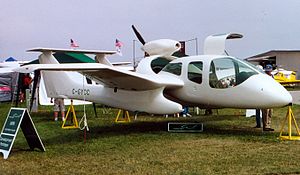| Creative Flight Aerocat | |
|---|---|

| |
| Aerocat prototype | |
| Role | Kit aircraftType of aircraft |
| National origin | Canada |
| Manufacturer | Creative Flight Auriga Design |
| Designer | Kirk Creelman |
| First flight | 15 July 2001 (single engine) 5 September 2002 (twin) |
| Introduction | 2001 |
| Status | Under development |
| Number built | One (2011) |
The Creative Flight Aerocat is a Canadian mid-wing, all composite, four passenger experimental aircraft that can be configured for amphibious float operations. Under development since 1998, the aircraft is intended to be supplied in kit form by Creative Flight of Haliburton, Ontario, for amateur construction. The company has since been renamed Auriga Design.
Design and development
Development started in 1998 on the MPA Aerocat. In 2002, the vehicle was renamed the Creative Flight Aerocat.
The all composite aircraft features a distinctive gull-wing design with pods that floats can attach to. A twin engine variant is powered by two Jabiru 3300 engines. In both the case of the single and twin engined versions, the engines are mounted in pusher configuration on a composite arch behind the cockpit.
Operational history
The single engine prototype flew in 2001, then was retrofitted for twin engine operations and flown in 2002. Shortly afterward the aircraft was test flown with floats.
In 2003, the prototype was flown to the EAA AirVenture Oshkosh airshow and displayed.
As of August 2019 the prototype, C-GYCC, remained the sole example flying.
Variants
- SR
- Single engine version with retractable gear, powered by a Crossflow CF4-20THO 250 hp (186 kW) engine.
- SRX
- Single engine version with retractable gear and floats, powered by a Crossflow CF4-20THO 250 hp (186 kW) engine or one Pratt & Whitney Canada PT6A-21 turboprop producing 480 hp (358 kW)
- TR
- Twin engine version with retractable gear, powered by two Jabiru 3300 120 hp (89 kW) engines
- TRX
- Twin engine version with retractable gear and floats, powered by two Jabiru 3300 120 hp (89 kW) engines
Specifications (Aerocat SR)
Data from Creative Flight
General characteristics
- Crew: 1
- Capacity: 3 passengers
- Length: 8.23 m (27 ft 0 in) (overall length)
- Wingspan: 10.36 m (34 ft 0 in)
- Height: 2.72 m (8 ft 11 in)
- Wing area: 15.33 m (165.0 sq ft)
- Airfoil: NLF 0215 (mod)
- Empty weight: 794 kg (1,750 lb)
- Gross weight: 1,361 kg (3,000 lb)
- Fuel capacity: 68 gallons
- Powerplant: 1 × Crossflow CF4-20THO , 190 kW (250 hp)
Performance
- Cruise speed: 298 km/h (185 mph, 161 kn)
- Stall speed: 80 km/h (50 mph, 43 kn)
- Rate of climb: 6.1 m/s (1,200 ft/min)
References
- ^ "Aerocat". Archived from the original on 12 February 2004. Retrieved 14 February 2011.
- ^ Downey, Julia: 2008 Kit Aircraft Directory, Kitplanes, Volume 24, Number 12, December 2007, page 47. Primedia Publications. ISSN 0891-1851
- ^ Vandermeullen, Richard: 2011 Kit Aircraft Buyer's Guide, Kitplanes, Volume 28, Number 12, December 2011, page 43. Belvoir Publications. ISSN 0891-1851
- Janes All the World's Aircraft. 2005.
- "Creative Flight Aerocat (Canada), Aircraft - Fixed-wing - Civil". Archived from the original on 15 August 2011. Retrieved 14 February 2011.
- Transport Canada (6 August 2019). "Canadian Civil Aircraft Register". Retrieved 6 August 2019.
- ^ Jackson 2007, pp. 77–78.
- Jackson, Paul, ed. (2007). Jane's All the World's Aircraft 2007–2008. Coulsdon, Surrey, UK: Jane's Information Group. ISBN 978-0-7106-2792-6.